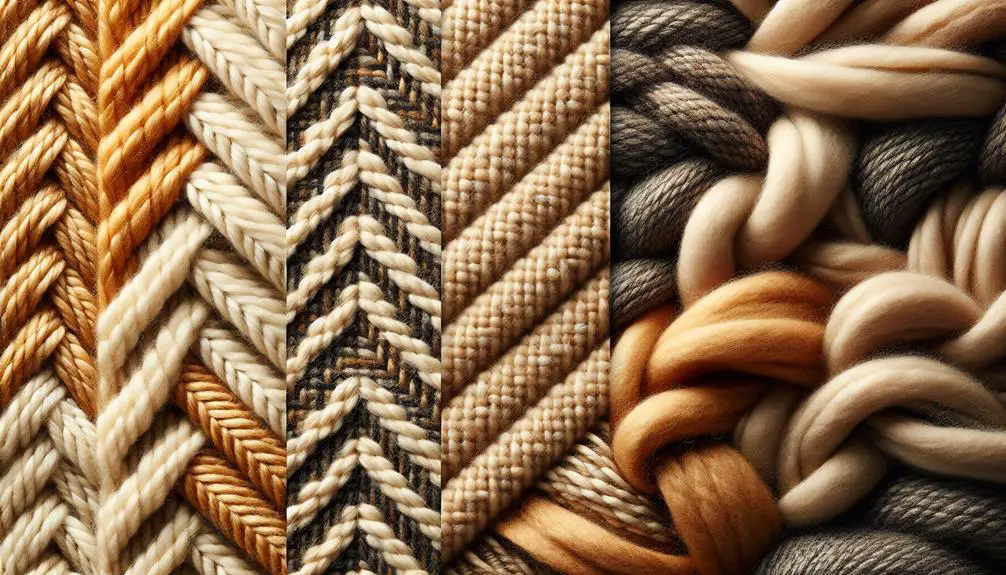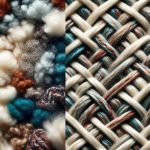Hey everyone, I've been thinking about the differences between tweed and wool lately, especially since I stumbled upon this fabulous tweed jacket the other day. It's interesting because both materials are cozy for winter wear, but they're quite different. Tweed is actually a type of wool, known for its unique texture and colorful patterns that come from different colored threads being woven together. Wool, on the other hand, is generally softer and smoother, coming from sheep and other animals. What really grabs my attention is how these fabrics hold up over time and their uses in various fashion pieces. What are your thoughts on the durability and style versatility between the two?
Table of Contents
Key Takeaways
- Tweed is a specific type of wool fabric known for its textured patterns and color variations.
- Wool refers to the fiber obtained from sheep and other animals, used in various fabrics.
- Tweed often incorporates blends of different fibers, including synthetic ones, for unique textures.
- Wool fabrics typically have simpler, more uniform weaves compared to tweed's complex patterns.
- Tweed is generally rougher and more rugged, while wool is smoother and offers a softer feel.
Defining Tweed and Wool
Let's clear up the confusion: tweed is a type of wool fabric known for its unique texture and patterns, while wool refers to the soft, curly fibers obtained from sheep and other animals. I've often noticed that people mix these two up, so I'm here to set the record straight with some straightforward details.
First off, the color variations in tweed are particularly remarkable. Unlike plain wool, tweed typically features a mix of different colored fibers, creating a multicolored effect that's not only visually appealing but also quite distinctive. This variety comes from blending various dyed wools before the weaving process, giving each tweed garment its unique character.
Moreover, let's talk about thermal properties. Both tweed and wool are excellent at keeping you warm, but tweed's tight weave and thicker hand make it particularly adept at insulation. This makes tweed an ideal choice for colder climates or seasons. While all wool provides some level of thermal protection due to the natural crimp of the fibers which traps air, tweed takes advantage of this property to a higher degree, offering superior warmth.
Historical Background
Let's take a quick look back at where tweed and wool come from.
Tweed has a fascinating origin linked to Scotland, where it was first created for its durability and warmth.
Meanwhile, wool has been a staple for centuries, used globally for everything from clothing to blankets.
Origin of Tweed
Tweed originated in Scotland during the 18th century, originally crafted by islanders to withstand harsh weather. Its durability quickly led to its popularity beyond just practical clothing; it became a fashion statement. I've seen how geographic production played a huge role. The fabric was mainly produced in the Outer Hebrides, and the local conditions influenced the texture and thickness, making it ideal for the cool, damp Scottish climate.
Its robust qualities and unique appearance, characterized by mixed flecks of color and intricate patterns, contributed to tweed's reputation worldwide. This fabric wasn't just a local commodity; it became integral to British identity and aesthetic, adored for its blend of style and practicality.
Wool's Ancient Uses
While tweed has its roots in Scotland, wool has been used worldwide since ancient times for various purposes. After the domestication of sheep, which dates back thousands of years, communities quickly realized the value of wool.
It's not just that it kept them warm; wool was also easy to dye and resilient, making it a staple for creating durable clothing and blankets. Wool trading became a significant economic activity.
As I explore its history, it's clear that wool's versatility made it a cornerstone in the development of early trade routes across continents. This isn't just about fabric; it's about a material that shaped economies and societies long before industrialization changed the game.
Raw Materials Used
Wool and other natural fibers form the basis of both tweed and traditional wool fabrics. When I investigate the raw materials used, it's not just about the fibers themselves but also about how they're sourced and their impact on our environment. Material sourcing, especially in the textile industry, has a significant footprint. That's why environmental sustainability becomes a critical dialogue here.
Let's break down the materials used:
- Wool: Primarily, wool comes from sheep. However, the quality and attributes vary tremendously based on the breed, climate, and shearing techniques. Merino, for instance, is highly prized for its softness and fineness.
- Other Animal Fibers: Beyond sheep, other animals like goats (cashmere and mohair), rabbits (angora), and even camels contribute fibers. Each has unique properties that dictate not just the feel and warmth of the fabric but also its sustainability profile.
- Plant Fibers: While less common, some tweeds incorporate plant-based materials like cotton or linen. These can affect the texture and breathability of the fabric, offering a different kind of environmental footprint—often lower in water and energy consumption.
Understanding these materials helps us appreciate not only the artistry behind fabric creation but also the broader impact of our clothing choices.
Weaving Techniques
Turning our attention to how these fabrics are crafted, let's explore the various weaving techniques used. Weaving, fundamentally, is the interlacing of threads to form fabric. Both tweed and wool can be woven on different loom types, which influence the fabric's texture and durability.
Tweed is typically produced on traditional looms where the thread tension can be tightly controlled. This essential factor is crucial because it determines how tightly the threads pull against each other, affecting everything from the fabric's feel to its insulating properties. For wool, both modern and traditional looms are used, but the choice depends on the desired fabric finish and production speed.
When weaving tweed, artisans often employ a plain or twill weave. This involves passing the weft thread over one warp thread and then under two or more, creating the characteristic diagonal lines seen in many tweeds. Wool fabrics might use similar techniques, but the patterns can vary more widely, depending on whether the end product is meant for sweaters, suits, or other garments.
Understanding loom types and managing thread tension are foundational in fabric production. Mastery of these elements allows weavers to manipulate the outcome, creating either a rugged, durable tweed or a soft, luxurious wool.
Textural Differences
When it comes to tweed and wool, the feel and look of these textiles are hugely impacted by their fiber composition and weave patterns. Tweed's often rougher texture contrasts sharply with wool's potentially smoother feel.
Let's explore how these factors contribute to their distinct surface experiences.
Fiber Composition Variation
Tweed and wool fabrics differ significantly in their fiber composition, impacting their texture and feel. When I explore the specifics, it's clear there's more to each fabric than meets the eye:
- Chemical Properties: Wool fibers are primarily protein-based, coming from animals like sheep. Tweed, however, often blends wool with synthetic fibers, which can alter its chemical structure and ultimately its behavior in various environments.
- Natural vs. Blended: Pure wool is exactly that—100% sheep's wool. Tweed mixes things up, combining wool with materials like cotton or silk, creating unique textural qualities and durability differences.
- Color Variations: Wool naturally accepts dyes well, offering vibrant color options. Tweed's mixed fibers contribute to more muted and complex color patterns, reflecting its varied composition.
Weave Pattern Contrast
Moving beyond fiber composition, let's now examine how tweed and wool differ in their weave patterns, adding distinct textural characteristics to each fabric. Tweed is renowned for its complex weave patterns that often include herringbone or checks, which not only contribute to its aesthetic appeal but also its texture richness. These patterns, combined with specks of color variations, create a multifaceted appearance that's quite popular in both fashion and home décor.
On the other hand, wool fabrics tend to have simpler, more uniform weaves. This simplicity doesn't detract from their appeal but highlights a different kind of beauty, one that's subtler yet equally valued. The pattern popularity in wool is generally less varied, focusing more on the quality and finish of the fabric itself.
Surface Feel Distinction
Let's now touch on how the surface feel of tweed and wool sets them apart. When you run your fingers over these materials, you'll notice distinct tactile perceptions due to their texture and fiber characteristics. Here's a quick breakdown:
- Coarseness: Tweed typically feels rougher than wool. Its texture has more pronounced coarseness, contributing to its rugged appearance.
- Softness: Wool varies greatly in softness, but it generally feels smoother and softer than tweed. This is especially true for fine wools like merino.
- Color variation: Tweed often exhibits greater color variation within the fabric itself, adding to its textured look. This isn't just visual; you can feel the differences as you touch different parts of the fabric.
Durability and Maintenance
When considering durability and maintenance, both tweed and wool offer significant benefits, but they do require different care strategies. Let's explore the specifics, particularly focusing on cleaning methods and stain resistance.
Tweed is remarkably durable, known for its tight weave and robust texture which naturally repels water and stains. This makes tweed an excellent choice for outerwear. You don't need to wash it frequently; spot cleaning and occasional dry cleaning will keep it in top shape. However, tweed can be prone to pilling, so a fabric shaver might become your best friend.
Wool, on the other hand, varies widely based on the breed of sheep and the weave of the fabric. Generally, wool is also stain-resistant to some extent, though not as much as tweed. It requires a bit more care to maintain its texture and color. Always use cold water for washing wool to prevent shrinking and distortion, and it's best to opt for air drying. A gentle brush after drying can help maintain its lush feel.
Common Uses in Apparel
How are tweed and wool commonly used in apparel?
Both materials have unique properties that make them favorites in the fashion world, especially when it comes to embracing seasonal trends and exploring color variations. Here's how:
- Outerwear: Tweed is famously used for jackets and coats. It's robust and water-resistant, making it ideal for autumn and winter wear. Wool, on the other hand, is a staple for sweaters and scarves. Its ability to regulate temperature keeps it on-trend for cold-weather essentials. Both fabrics thrive in rich, varied color palettes, enhancing their appeal each season.
- Formal Wear: Tweed suits have a distinct style, often favored in traditional and country settings, but they're also making waves in urban fashion with modern cuts and fits. Wool suits are a classic choice, valued for their warmth, breathability, and versatility in both subtle and bold colors, aligning perfectly with professional and ceremonial attire.
- Accessories: Both tweed and wool find their way into accessories like hats, gloves, and even bags. These items often showcase the natural texture and color depth of the fabrics, making each piece uniquely attractive while providing functional warmth and style.
Understanding these uses helps you appreciate the craftsmanship behind each material's incorporation into daily and special occasion wear.
Popular in Home Decor
Tweed and wool aren't just for clothing; they're also increasingly popular in home decor for their texture and warmth. I've noticed more designers are integrating these materials into interiors, tapping into the latest color trends and design innovations to elevate spaces.
In my own experience, both tweed and wool are fantastic for creating a cozy ambiance. Wool throws and tweed cushions are common, but there's more to explore. For instance, woolen rugs have become a staple in homes, not only for their durability but also for their ability to add a soft, inviting look to any room. They're perfect for those chilly evenings when all you want is to sink your feet into something warm.
Moreover, tweed's unique texture brings a rustic charm that complements modern and traditional decor alike. I've seen it used in everything from upholstered furniture to wall coverings. This adaptability is key, especially when considering the latest design innovations. Designers are mixing tweed with other materials like leather and metal for a contemporary twist that still feels timeless.
These fabrics aren't just practical; they're style statements, aligning perfectly with the dynamic shifts in home design trends. Their rich textures and versatile aesthetics make them ideal choices for anyone looking to enhance their living space.
Price Comparison
When we look at tweed and wool, it's interesting to see how their prices stack up. Generally, tweed can be pricier due to its intricate weaving processes and patterns.
However, both materials hold their value well over time, which is great if you're thinking of investing in some high-quality fabric.
Average Market Costs
Why do the prices of tweed and wool vary so much in the market? It's all about understanding the nuances of market fluctuations and gauging their investment potential. Here's what shapes the costs:
- Production Complexity: Tweed, often handwoven and involving intricate patterns, demands higher labor and skill levels compared to more straightforward wool fabrics. This complexity drives up its price.
- Raw Material Quality: The quality of the wool used in tweed can be superior, influencing the final product's cost. Pure wool varies in price based on its source and texture.
- Supply and Demand: Limited availability of high-quality tweed and seasonal demand spikes can push prices up, while wool is generally more abundant and stable in price.
Value Over Time
Let's explore how the values of tweed and wool have shifted over the years. Initially, both materials were fairly staple, but with the rise of fashion trends and modern adaptations, their value trajectories have diverged substantially. Tweed, with its rich heritage and bespoke appeal, has seen a robust rise as a luxury fabric, making it a sound investment. Meanwhile, wool remains a classic but has had to adapt to compete with synthetic alternatives.
| Year | Tweed Value | Wool Value |
|---|---|---|
| 1990s | Moderate | High |
| 2000s | Increasing | Stable |
| 2020s | High | Moderate |
This table highlights the broader investment trends, showing how market preferences and innovations influence fabric valuation.
Environmental Impact
Examining the environmental impact, both tweed and wool production have significant ecological footprints due to their resource-intensive processes. When I dig into the details, it's clear that both materials demand a lot from our environment, though in slightly different ways. Here's a breakdown:
- Production Emissions: Both tweed and wool generate considerable greenhouse gases during production. For wool, it's mainly from sheep farming—think methane from the sheep and energy consumption during fleece processing. Tweed, often woven from wool, adds another layer of complexity with its dyeing and finishing processes, which can also be pretty heavy on chemicals and water usage.
- Land Use: Large areas of land are needed for grazing sheep, which impacts biodiversity and can lead to soil erosion and degradation if not managed sustainably. Tweed production doesn't directly add to this, but since it's primarily made from wool, the footprint extends.
- Recycling Practices: On a positive note, both tweed and wool garments are stellar when it comes to recyclability. They can be reused or repurposed to reduce the demand on virgin resources, which helps mitigate some of their environmental burdens.
Frequently Asked Questions
Can Tweed Be Dyed Into Any Color Like Wool?
Yes, tweed can be dyed in various colors, much like wool. However, its dyeing techniques and color retention may vary based on the specific blend and quality of the tweed fabric.
Is Tweed Suitable for Summer Clothing?
I'd say tweed isn't ideal for summer clothing. It lacks the fabric breathability needed for hot weather, making lighter, airier materials better choices for summer styles. Stick to cotton or linen instead.
How Do I Identify Authentic Tweed?
To identify authentic tweed, I examine the texture and weaving patterns closely. Authentic tweed has a rough texture and distinctive, complex patterns that are often unique to specific regions or weavers.
Are There Hypoallergenic Types of Wool?
Yes, there are hypoallergenic types of wool. Merino wool is especially allergy-friendly due to its fine fibers, which offer benefits like reduced itchiness and irritation, making it a great choice for sensitive skin.
Can Wool Garments Be Stretched After Shrinking?
I've found that you can stretch wool garments after shrinking by using careful stretching techniques. To prevent future shrinking, always follow the care label and avoid high heat when washing and drying.
- Is Percale a Good Weave? An Analysis of Its Durability and Feel - July 14, 2025
- What Is Percale Made Out Of? A Guide to the Fibers - July 14, 2025
- What Is a Percolator and How Does It Make Coffee? - July 14, 2025







